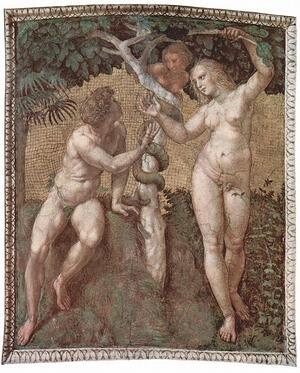As Old as Lilith and Eve: “The Mediator between the Head and Hands is the Heart!”
This painting depicts Lilith as the snake tempting Adam and Eve to
eat the apple in the Garden of Eden. Raffaello Sanzio, 1508.
Last Sunday, after a totaled car and a summarily canceled day-trip to Ipswich, MA, my friend and I decided to make the best of things and not let a little thing like a car accident ruin our day. What better activity than seeing a German Expressionist film about robots, class struggle, and compassion? Alas, while there are many great things one can say about the film, I was angered by the predictably dualistic depiction of women, a theme as old as Lilith and Eve.
Fritz Lang’s 1927 film Metropolis was produced in Weimar Republic Germany, and exemplifies German Expressionist film, that dark and moody matter. The film shows the story of a dystopia – Metropolis—run by Joh Fredersen from his ominously named “Babel” tower, and the sea of working masses that fuel the city’s lights, tuxedos and frivolity. The elites are immaculately groomed in suits and slicked coifs, laying plans in high-rises that literally scrape the heavens. The workers live far beneath the earth, slaves to unrelenting machines in a “worker’s city.” When we see the workers, they are a homogenous pack of exhausted drones, their heads hanging low as they trudge dutifully from one miserable task to the next.
There are no women in the film until we meet Maria, an angelic sympathizer of the workers who preaches patience and hope, proclaiming that the workers must not act rashly but instead await the Mediator between their world and the world above. Fredersen determines that Maria is a threat, and orders mad-scientist Rotwang to make his near-perfect robot (Maschinenmensch) in Maria’s likeness. The robot Evil Maria convinces the workers to destroy the city that sustains them, flooding their homes and machines, nearly drowning the workers’ own children. On Evil Maria’s sensual command, the workers spill above ground in a wild man-hunt for Joh Fredersen, their oppressor. Good Maria eventually wakes up from her harrowing medical procedure (unscathed), and is appalled when she learns of her alter-ego. Good Maria duly saves the worker’s children and hides behind a statue of an apostle outside the ground-level Gothic cathedral while the workers burn Evil Maria just outside the holy doors. In the final scene, Joh Fredersen’s son, joins the Head (Joh) and the Hands (the head foreman among the workers), becoming the mediating Heart.
Beyond the lesson of conscience (the Heart) mediating the plans of the Head and the actions of the Hands, I would like to lament the all-too-predictably dualistic nature of Maria. Good Maria is inherently good, saving children, preaching patience, modestly dressed, gentle, sweet and kind. Evil Maria is sexy (we see her perform a half-nude erotic dance before the male elite of the Above World in a nightclub at one juncture), manipulative, wears a lower neckline than Good Maria, winks compulsively and laughs demonically as she is burned at the stake upon having nearly destroyed all of Metropolis. This is an age old problem for women: perpetually portrayed as saints or sinners, with very little room to wiggle. Even in a film predicated on dualism, Maria’s stands out and remains unresolved. Instead of Maria taking on the responsibilities of the Heart, she fades into the background as the three men glow in their new-found harmony.
Lilith and Eve, two Biblical women, have suffered Maria’s plight. According to Rebecca Lesses’ article, "Lilith," Adam’s disobedient first wife who desired equal treatment, has historically been represented as a demonic baby-snatcher, baby-murderer and seductress in the night. God created Eve to be Adam’s new companion, but she too has been vilified by history and theology by eating that fatefully forbidden fruit. Lucky for Lilith, she has been reclaimed by feminists into a role model of independence, lending her name to a Jewish feminist magazine, Lilith, and a feminist music festival, Lilith Fair. On a more religious note, feminist theologian Judith Plaskow has written an excellent interpretation of Lilith’s story. In Plaskow’s version, at first suspicious of exiled Lilith because of the terrible things Adam told her, Eve slips over the garden walls and befriends this misrepresented woman. In the end, Plaskow writes: “And God and Adam were expectant and afraid the day Eve and Lilith returned to the garden, bursting with possibilities, ready to rebuild it together.” In this version, Lilith and Eve have bypassed the essentialized roles of Head, Heart and Hands. The women take it upon themselves to think, plan, and act with conscience.
What recent media examples of dualistic feminine roles can you think of? Do you think much has changed since 1927?







I almost wonder if Exorcism movies could count here - that the girls are good and pure, until the devil gets inside them. And they need to be exorcised to become good and pure again. (This is mainly on my mind because I follow Eli Roth on Twitter, and he is promoting his new movie, "The Last Exorcist."
As insightful and thought provoking as ever, Alma. I will be sure to watch the film. Unfortunately I can think of far too many films that fit this formula, and even more where the "strong female characters" are neutralized by the film's end. (Thelma and Louise comes to mind as the most obvious example) And as much as it pains me, I send you to this recent Maureen Dowd column in a similar vein, suggesting it seems that maybe things have changed. http://www.nytimes.com/2010/08...